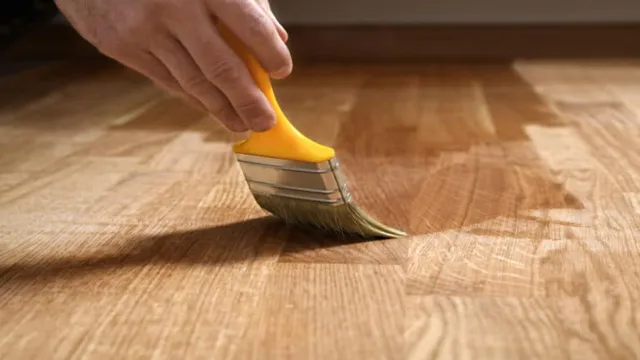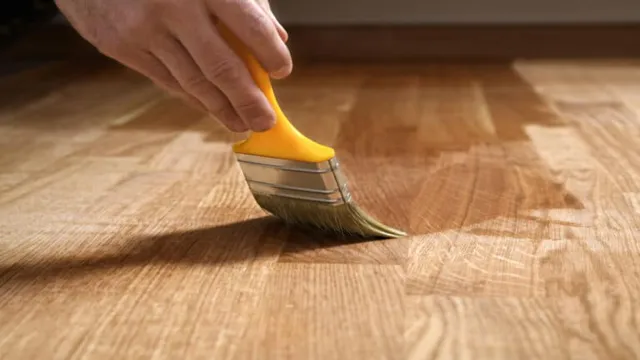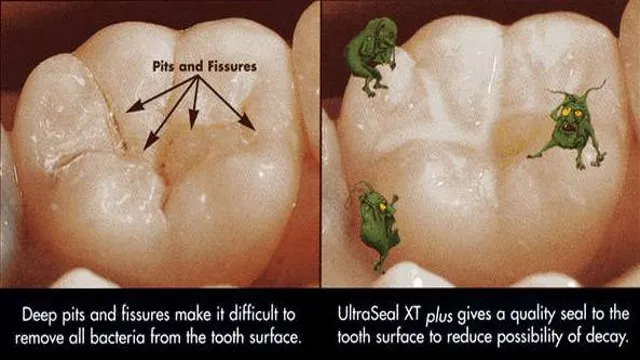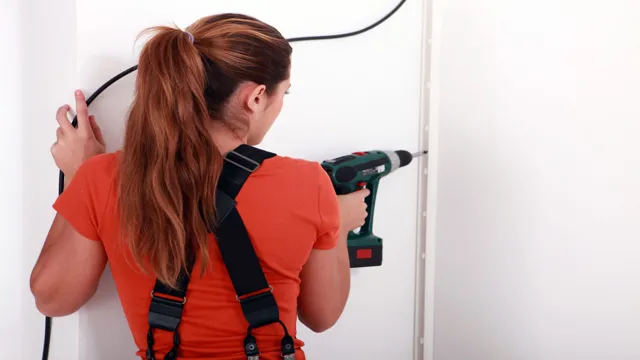How to Clean Planer Rollers Like a Pro: Tips and Tricks for Keeping Your Tools in Top Shape
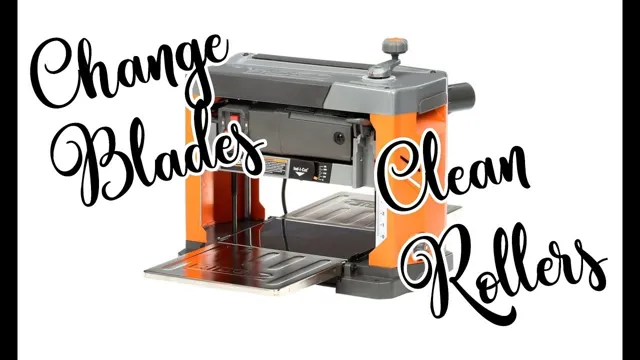
Do you find that your planer rollers aren’t performing as well as they used to? Perhaps they’re not as smooth, or maybe they’re leaving rough marks on your wood. Whatever the issue, it’s likely that your planer rollers need a good cleaning to get them back to their optimal level of performance. Luckily, cleaning planer rollers isn’t a difficult task and can be done easily with a few simple steps.
In this blog, we’ll explore the best ways to clean your planer rollers and get them working like new again. So, let’s dive in and get your planer back in top form!
Gather Necessary Tools
If you’ve never cleaned your planer rollers before, then it’s natural to feel a little overwhelmed. However, the first step to making sure that your planer runs smoothly and efficiently is to gather all the necessary tools you’ll need for the task. You’ll want to start by collecting a few basic materials, such as a lint-free cloth, some cleaning solution, and some aluminum foil.
You’ll also want to make sure you have a wrench or a socket set that you can use to remove the rollers from the planer. Once you have all your materials, it’s time to get started!
Lint-free cloths, denatured alcohol, wire brush, and scrap wood
When it comes to cleaning and maintaining your tools, it’s important to have the right materials on hand. For cleaning metal tools like chisels, planes, and saw blades, you’ll need lint-free cloths, denatured alcohol, and a wire brush. The lint-free cloths will prevent any fibers from getting caught in your tools, while the denatured alcohol will dissolve any oils or gunk that may have accumulated on the metal over time.
The wire brush can be used to scrub away any stubborn debris that may be stuck on the surface of your tools. And don’t forget to use scrap wood as a backing to avoid damaging the edges or tips of your sharp tools! With these tools at your disposal, you can ensure that your metal tools stay clean, sharp, and in excellent condition for years to come. So, before you begin any project, take some time to gather all the necessary tools and materials to keep your tools in tip-top shape.
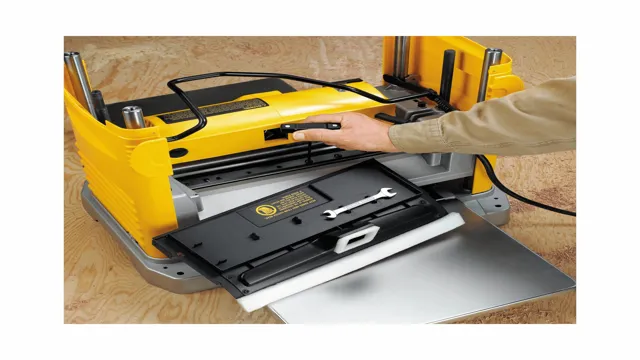
Disconnect the Planer
If you’re looking to give your planer a thorough cleaning, you’ll need to start by disconnecting the machine from its power source. This is crucial for your safety and the safety of your equipment. Once you’ve disconnected the planer, you can focus on cleaning the rollers.
The rollers are responsible for feeding the wood through the planer and ensuring an even finish. Over time, debris and sawdust can build up on the rollers, affecting their performance. To clean the rollers, start by removing any large debris with a brush or vacuum.
Next, use a lint-free cloth and a cleaning solution to wipe down the rollers. Be sure to avoid using any abrasive cleaners that could damage the rollers. With a little bit of care and attention, your planer rollers will be clean and ready to tackle your next project!
Unplug the planer or turn off the power switch to prevent accidents.
When using a planer, it’s important to always prioritize safety to prevent accidents that can lead to serious injuries. One of the most critical steps in this regard is to disconnect the planer before working on it or making any adjustments. This means either unplugging the power cord or turning off the power switch, depending on the type of planer you’re using.
Doing so ensures that there’s no electricity flowing through the machine and eliminates the risk of electric shock or other similar accidents. It’s always a good practice to double-check that the planer is disconnected before starting any work, and to keep it unplugged until you’re completely finished using it. By taking this simple but effective step, you can ensure your safety and that of those around you while enjoying the benefits of working with a planer.
Remove the Rollers
If you want to keep your planer running smoothly, you need to clean the rollers. But before you dive in, you should know how to remove the rollers properly. Fortunately, it’s not a complicated process.
Simply unplug the machine and remove the dust cover. Then, you’ll need to loosen the belt tension and remove the drive belt. After that, remove the Allen screws on the sides of the roller holder and slide the rollers out.
It’s important that you keep track of which roller goes where, as you’ll need to put them back in the proper position. Once the rollers are removed, you can clean them thoroughly and get them ready for reinstallation. By taking the time to remove the rollers properly, you can ensure that your planer stays in top condition for years to come.
So, get your tools ready and let’s get started!
Refer to your planer’s manual to remove the rollers safely.
If you’re about to remove the rollers on your planer, the first thing you should do is refer to your manual. This will give you the knowledge you need to do it safely and efficiently. Removing your rollers can be tricky and should be done with care.
This is especially important if you’re working with a larger or more powerful planer. When you’re removing the rollers, be sure to use proper safety precautions such as locking out the power supply and using gloves to protect your hands. Once you’ve made sure you’re ready to go, carefully remove the retaining bolts and slide the rollers out.
Be sure to check the rollers for any damage or wear and replace them if necessary. With a little bit of know-how, you can safely and easily remove your rollers and keep your planer running smoothly.
Clean the Rollers
If you’ve noticed your planer is not working as well as it used to, it’s possible that your rollers are dirty. Over time, the rollers in your planer can accumulate dust, debris, and other unwanted materials that can lead to poor performance. To clean your planer rollers, start by unplugging the tool and removing the covers that protect the rollers.
Then, use a clean cloth to wipe away any debris or dust. If there is more buildup, you can use a brush, like a toothbrush, to gently scrub the rollers. Be careful not to damage the rollers or push debris further into the machine.
Once you have cleaned the rollers, replace the covers and plug in the tool. Now, your planer should run smoothly and effectively. Keep in mind that regular maintenance and cleaning can help extend the life of your tool and prevent issues from arising in the future.
Use a lint-free cloth to wipe down the rollers, then use a wire brush to remove any debris.
Cleaning the rollers of your printing machine is essential for proper maintenance and optimal performance. To get started, grab a lint-free cloth and wipe down the rollers to remove any dust or debris. This will ensure that the surface is clean and ready for the next step.
Next, use a wire brush to remove any stubborn particles that are lodged in the rollers. This may require some elbow grease, but it’s important to make sure that every inch of the rollers is debris-free. Think of it like brushing your teeth; you want to make sure you get into all the nooks and crannies to get the best results.
Once you’re satisfied that the rollers are clean, wipe them down one more time with the lint-free cloth and you’re good to go. Regularly cleaning your rollers will not only extend their lifespan, but it will also improve the quality of your prints. So, don’t neglect this important maintenance task!
Clean the Sides of the Rollers
If you own a planer, it’s important to know how to properly clean its rollers. One of the most crucial steps in this process is cleaning the sides of the rollers. Over time, debris and sawdust can accumulate on the sides of the rollers, which can cause them to become less effective and impact the quality of your work.
To clean the sides of the rollers, start by unplugging the planer and removing the cover. Then, use a soft-bristled brush or a cloth to gently wipe away any debris. Avoid using harsh chemicals or abrasive materials that could damage the rollers.
Once you’ve cleaned the sides, be sure to clean the top and bottom of the rollers as well. By keeping your planer rollers clean, you can ensure that your tool is working properly and producing high-quality results.
Use a scrap piece of wood to hold the rollers in place while you clean the sides with a lint-free cloth and denatured alcohol.
If you want to keep your printer running smoothly, it’s essential to clean the sides of the rollers. Over time, dust and debris can accumulate on the rollers, causing them to jam or produce smudged prints. However, cleaning the sides of the rollers can be tricky, as it requires you to hold the rollers in place while you wipe them down.
To make this task easier, I recommend using a scrap piece of wood or plastic to hold the rollers steady while you clean the sides with a lint-free cloth and denatured alcohol. This will allow you to get in between the tight spaces and remove any residue without damaging the delicate printer parts. Don’t forget to take your time and be gentle, as excessive force can cause the rollers to become misaligned or damaged.
With a little care and attention, you can easily clean your printer’s rollers and ensure that they continue to work flawlessly for years to come.
Reinstall the Rollers
Once you have cleaned the rollers of your planer, it’s time to reinstall them properly. To do this, first ensure that both rollers are in the “up” position. Then, slide the first roller into place, making sure that it sits securely on its bearings.
Next, align the second roller with the first and gently push it into place until it too sits securely on its bearings. Double-check to ensure that both rollers are level and parallel. Finally, lightly tighten the roller-adjustment screws, taking care not to over-tighten them.
Once you’re satisfied that both rollers are properly aligned and secured, you can then proceed with adjusting the planer’s cutting depth and other settings to get the perfect finish on your workpieces. With your planer’s rollers securely in place, you should be able to achieve consistent, smooth planing results with ease.
Once the rollers are clean, reinstall them according to the manufacturer’s instructions.
After cleaning the rollers of your printer, the next step is to reinstall them properly. Before anything else, make sure to follow the manufacturer’s instructions to avoid damaging the rollers or other printer components. Some printer models have rollers that require manual installation, while others have automatic clip-on mechanisms for easy installation.
If your printer uses manual installation, you will need to line up the rollers with their respective slots. Once you have aligned them properly, apply gentle pressure to snap them into place. If your printer has automatic clip-on mechanisms, simply slide the rollers back into their slots until you hear a click.
Remember to check if each roller is properly secured. Lastly, it is best to avoid touching the rollers with your bare hands as oils and dirt from your skin can accumulate and damage them. It is essential to reinstall the rollers correctly to ensure the smooth and efficient operation of your printer.
Incorrect installation can cause paper jams, ink smudges, and inconsistent print quality. Always refer to the user manual or contact customer support if you have questions or concerns about the installation process. Keeping your printer’s rollers clean and properly installed will prolong its lifespan, reduce the frequency of maintenance, and save you money in the long run.
Remember the importance of proper maintenance for your printer to perform at its best and last for years to come.
Test the Planer
If you want to ensure the best results from your planer, it’s essential to regularly clean your planer rollers. Over time, wood pitch and debris can build up on the rollers, reducing their effectiveness and making them more prone to damage. To clean the rollers, first, unplug the planer and remove the dust hood.
Use a scraper or a putty knife to scrape off any large chunks of debris, and then use a soft brush or cloth to wipe away any remaining dust or dirt. You may also want to use a cleaning solution designed for planer rollers, taking care to follow any instructions carefully. Once you’ve finished, be sure to replace the dust hood and any other parts you removed, plug in the planer, and test it to ensure everything is working correctly.
With a little bit of care and attention, you can keep your planer running smoothly for years to come.
After cleaning, plug the planer back in and test it before using it on a project.
When it comes to using a planer, it’s important to test it out before taking on a big project. After all, how disappointing would it be to realize halfway through that the planer isn’t working correctly? Once you’ve finished cleaning the planer, plug it back in and run a few test pieces through it. This will not only ensure that it’s working properly but also give you a chance to adjust any settings or make any necessary tweaks.
Trust us, taking a few extra minutes to test the planer now can save you a lot of time and frustration later on. Keywords: planer, project, cleaning, test, adjust, settings.
Conclusion
After following these steps to clean your planer rollers, you’ll have blades gliding like a bald eagle on a warm summer day. A little bit of TLC for your trusty woodworking tool will make sure it keeps churning out those smooth and polished boards for years to come. So go ahead, give those rollers the spa day they deserve and bask in the satisfaction of a job well done.
“
FAQs
1. How often should I clean my planer rollers? A: It is recommended to clean your planer rollers after every use to ensure optimal performance and longevity. 2. What is the best method for cleaning planer rollers? A: The best method is to use a soft cloth or brush to clean any dust or debris from the rollers. For tougher buildup, you can use a mild cleaner or solvent. 3. Can I use water to clean my planer rollers? A: It is not recommended to use water to clean planer rollers as it can cause rust and damage to the machine. Instead, use a mild cleaner or solvent. 4. Should I lubricate my planer rollers after cleaning? A: Yes, it is recommended to apply a light coat of lubricant to the rollers after cleaning to ensure smooth operation. 5. How can I prevent buildup on my planer rollers? A: To prevent buildup, make sure to clean your rollers regularly and avoid using dirty or wet wood. 6. Can I use sandpaper to clean my planer rollers? A: No, sandpaper is too abrasive and can damage the rollers. Stick to using a soft cloth or brush. 7. Is it necessary to remove the rollers for cleaning? A: It is not necessary to remove the rollers for cleaning, but it may make the process easier and more thorough. Consult your machine manual for instructions.

